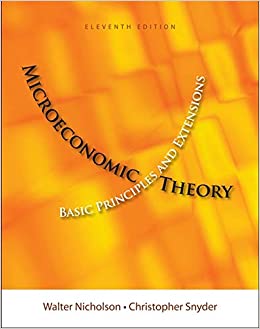
Microeconomic Theory 11th Edition by Walter Nicholson,Christopher Snyder
Edition 11ISBN: 978-1111525538
Microeconomic Theory 11th Edition by Walter Nicholson,Christopher Snyder
Edition 11ISBN: 978-1111525538 Exercise 2
David N. gets $3 per week as an allowance to spend any way he pleases. Because he likes only peanut butter and jelly sandwiches, he spends the entire amount on peanut butter (at $0.05 per ounce) and jelly (at $0.10 per ounce). Bread is provided free of charge by a concerned neighbor. David is a particular eater and makes his sandwiches with exactly 1 ounce of jelly and 2 ounces of peanut butter. He is set in his ways and will never change these proportions.
a. How much peanut butter and jelly will David buy with his $3 allowance in a week?
b. Suppose the price of jelly were to increase to $0.15 an ounce. How much of each commodity would be bought?
c. By how much should David's allowance be increased to compensate for the increase in the price of jelly in part (b)?
d. Graph your results in parts (a) to (c).
e. In what sense does this problem involve only a single commodity, peanut butter and jelly sandwiches? Graph the demand curve for this single commodity.
f. Discuss the results of this problem in terms of the income and substitution effects involved in the demand for jelly.
a. How much peanut butter and jelly will David buy with his $3 allowance in a week?
b. Suppose the price of jelly were to increase to $0.15 an ounce. How much of each commodity would be bought?
c. By how much should David's allowance be increased to compensate for the increase in the price of jelly in part (b)?
d. Graph your results in parts (a) to (c).
e. In what sense does this problem involve only a single commodity, peanut butter and jelly sandwiches? Graph the demand curve for this single commodity.
f. Discuss the results of this problem in terms of the income and substitution effects involved in the demand for jelly.
Explanation
Complementary goods are the goods that a...
Microeconomic Theory 11th Edition by Walter Nicholson,Christopher Snyder
Why don’t you like this exercise?
Other Minimum 8 character and maximum 255 character
Character 255


